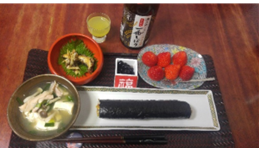Setsubun/Ehomaki
Yoshie Doi
 |
 |
Ehomaki and Iwashi(Sadine) Eho-maki cooked by Okudo (Made by Fukuyoshi)
Mamemaki, Ehomaki, and Hatsuuma’s Inari sushi were also offered and worshiped at the start stage . At some point, the ehomai changed to the ehomaki. It seems that people who enshrined Inari at shrines and homes that enshrined Inari in Hatsuuma.
It became the basis of the business that people eat rather than offering Inari sushi, which has become a boom in recent years.
Setsubun is the turning point of the four seasons, and to be exact, it happens four times a year. In the lunar calendar, the beginning of the year was the first day of spring, so it came to refer to Setsubun in February. Setsubun in February corresponds to the New Year in the lunar calendar. The 15th day counting from the Daikan (Coldest weather season) was the day before the first day of spring, so it was called New Year’s Eve. The next day was Risshun Shogatsu, the beginning of the year. At the turn of the season, evil spirits set in, and he often fell ill, so it seems that he threw beans at night. It is an event introduced from China in the Asuka period, but Setsubun and bean-scattering were held separately.
At that time, the imperial court held an event called Tsuina Oniyarai to ward off demons. Beans are known to destroy demons and have the power to destroy demons.
Recently, although I don’t see it very often, there was also a custom of sticking a sardine’s head into a holly branch and hanging it in a doorway, roasting the sardine’s head over a fire and letting the smoke rise. Recently, instead of sardines, ehomaki rolls have been sold, and department stores and supermarkets have long lines to purchase them.
This ehomaki is said to have originated in the Senba area of Osaka, but this is not certain. It is said that from the end of the Edo period to the beginning of the Meiji period, women in the entertainment districts of Osaka ate it as a form of entertainment as part of their love for the men they liked. In the Kansai region, there was a custom of visiting shrines and temples that correspond to the auspicious direction of the year. It is thought that the custom of emphasizing eho was also a hint.
In 1989, a convenience store in Hiroshima Prefecture sold this ehomaki, sofar which is mainly sold in Osaka and Kansai , and it became a national confectionery. An organization in the seaweed industry designated Setsubun in February as ‘Norimaki Day’. February and August is called Nippachi, the month when sales decline.
In that sense, Ehomaki and Valentine’s Day are also recent booms that were conceived from the business side.
A department store in Kyoto sells luxury ehomaki wrapped in gold leaf, The Ritz-Carlton Kyoto sells ehomaki for the first time since its founding, soup stock ehomaki, sweets ehomaki, etc. doing.
When I checked with long-established sushi restaurants and nori stores in Kyoto, they were selling ehomaki in the early 1970s.
The end of document
